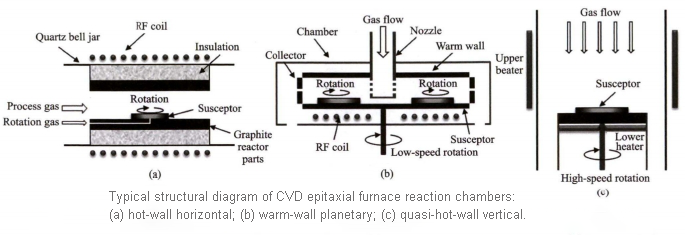Silicon carbide (SiC) substrates have numerous defects that prevent direct processing. To create chip wafers, a specific single-crystal film must be grown on the SiC substrate through an epitaxial process. This film is known as the epitaxial layer. Nearly all SiC devices are realized on epitaxial materials, and high-quality homoepitaxial SiC materials form the foundation for SiC device development. The performance of epitaxial materials directly determines the performance of SiC devices.
High-current and high-reliability SiC devices impose stringent requirements on the surface morphology, defect density, doping uniformity, and thickness uniformity of epitaxial materials. Achieving large-size, low-defect density, and high-uniformity SiC epitaxy has become critical for the development of the SiC industry.
Producing high-quality SiC epitaxy relies on advanced processes and equipment. Currently, the most widely used method for SiC epitaxial growth is Chemical Vapor Deposition (CVD). CVD offers precise control over epitaxial film thickness and doping concentration, low defect density, moderate growth rate, and automated process control, making it a reliable technology for successful commercial applications.
SiC CVD epitaxy generally employs hot-wall or warm-wall CVD equipment. High growth temperatures (1500–1700°C) ensure the continuation of the 4H-SiC crystalline form. Based on the relationship between the gas flow direction and the substrate surface, the reaction chambers of these CVD systems can be classified into horizontal and vertical structures.
The quality of SiC epitaxial furnaces is mainly judged on three aspects: epitaxial growth performance (including thickness uniformity, doping uniformity, defect rate, and growth rate), temperature performance of the equipment (including heating/cooling rates, maximum temperature, and temperature uniformity), and cost-effectiveness (including unit price and production capacity).
Differences Between Three Types of SiC Epitaxial Growth Furnaces
1.Hot-wall Horizontal CVD Systems:
-Features: Generally feature single-wafer large-size growth systems driven by gas floatation rotation, achieving excellent intra-wafer metrics.
-Representative Model: LPE’s Pe1O6, capable of automated wafer loading/unloading at 900°C. Known for high growth rates, short epitaxial cycles, and consistent intra-wafer and inter-run performance.
-Performance: For 4-6 inch 4H-SiC epitaxial wafers with thickness ≤30μm, it achieves intra-wafer thickness non-uniformity ≤2%, doping concentration non-uniformity ≤5%, surface defect density ≤1 cm-², and defect-free surface area (2mm×2mm cells) ≥90%.
-Domestic Manufacturers: Companies like Jingsheng Mechatronics, CETC 48, North Huachuang, and Nasset Intelligent have developed similar single-wafer SiC epitaxial equipment with scaled-up production.
2.Warm-wall Planetary CVD Systems:
-Features: Use planetary arrangement bases for multi-wafer growth per batch, significantly improving output efficiency.
-Representative Models: Aixtron’s AIXG5WWC (8x150mm) and G10-SiC (9x150mm or 6x200mm) series.
-Performance: For 6-inch 4H-SiC epitaxial wafers with thickness ≤10μm, it achieves inter-wafer thickness deviation ±2.5%, intra-wafer thickness non-uniformity 2%, inter-wafer doping concentration deviation ±5%, and intra-wafer doping concentration non-uniformity <2%.
-Challenges: Limited adoption in domestic markets due to lack of batch production data, technical barriers in temperature and flow field control, and ongoing R&D without large-scale implementation.
3. Quasi-hot-wall Vertical CVD Systems:
- Features: Utilize external mechanical assistance for high-speed substrate rotation, reducing boundary layer thickness and improving epitaxial growth rate, with inherent advantages in defect control.
- Representative Models: Nuflare’s single-wafer EPIREVOS6 and EPIREVOS8.
- Performance: Achieves growth rates over 50μm/h, surface defect density control below 0.1 cm-², and intra-wafer thickness and doping concentration non-uniformity of 1% and 2.6%, respectively.
- Domestic Development: Companies like Xingsandai and Jingsheng Mechatronics have designed similar equipment but have not achieved large-scale use.
Summary
Each of the three structural types of SiC epitaxial growth equipment has distinct characteristics and occupies specific market segments based on application requirements. Hot-wall horizontal CVD offers ultra-fast growth rates and balanced quality and uniformity but has lower production efficiency due to single-wafer processing. Warm-wall planetary CVD significantly enhances production efficiency but faces challenges in multi-wafer consistency control. Quasi-hot-wall vertical CVD excels in defect control with complex structure and requires extensive maintenance and operational experience.
As the industry evolves, iterative optimization and upgrades in these equipment structures will lead to increasingly refined configurations, playing crucial roles in meeting diverse epitaxial wafer specifications for thickness and defect requirements.
Advantages and Disadvantages of Different SiC Epitaxial Growth Furnaces
|
Furnace Type |
Advantages |
Disadvantages |
Representative Manufacturers |
|
Hot-wall Horizontal CVD |
Fast growth rate, simple structure, easy maintenance |
Short maintenance cycle |
LPE (Italy), TEL (Japan) |
|
Warm-wall Planetary CVD |
High production capacity, efficient |
Complex structure, difficult consistency control |
Aixtron (Germany) |
|
Quasi-hot-wall Vertical CVD |
Excellent defect control, long maintenance cycle |
Complex structure, difficult to maintain |
Nuflare (Japan) |
With continuous industry development, these three types of equipment will undergo iterative structural optimization and upgrades, leading to increasingly refined configurations that match various epitaxial wafer specifications for thickness and defect requirements.
Post time: Jul-19-2024

